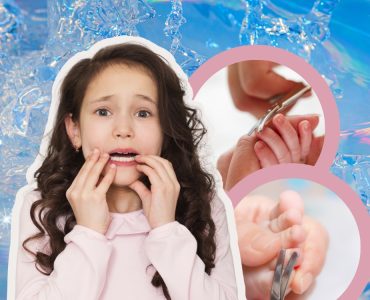As parents or caregivers, we always strive to ensure the well-being of our little ones. While we may pay attention to their overall health, it’s easy to overlook the importance of nail care in their daily routine. However, maintaining healthy nails for your toddler should be a priority.

In this article, we will explore five compelling reasons why nail care should be at the forefront of your toddler’s health priorities. By understanding these reasons, you’ll be equipped with the knowledge to provide proper nail care and promote your child’s overall well-being.
Preventing Accidental Scratches and Injuries
The Common Occurrence of Scratches
Accidental scratches are a common occurrence among toddlers, especially when their nails are not properly maintained. Toddlers have a natural curiosity and tendency to explore their surroundings with their hands. Their untrimmed nails can inadvertently cause scratches on their delicate skin, leading to discomfort, pain, and potential complications.
The Risks of Long Nails
Long nails increase the likelihood of accidental scratches and injuries. Toddlers often engage in activities that involve hand movements, such as playing, crawling, and exploring objects. If their nails are excessively long, there’s a higher chance of them inadvertently scratching themselves or others. Furthermore, long nails can get caught in clothing, blankets, or other items, causing discomfort and potential injury.
Potential Harm and Discomfort
Untrimmed nails pose a risk of not only scratching the skin but also causing discomfort for your toddler. When nails grow too long, they can curl and press against the fingertips, leading to pain and irritation. Additionally, dirt and debris can accumulate under long nails, which may result in infections or skin issues if not addressed promptly.
The Importance of Regular Nail Trimming
Regular nail trimming is a simple yet effective measure to prevent accidental scratches and injuries. By keeping your toddler’s nails short and well-maintained, you can significantly reduce the risk of them hurting themselves or others. Trimming their nails ensures that the edges are smooth and less likely to cause harm, giving you peace of mind knowing that your little one is safe during their explorations.
Gentle Nail Filing as an Alternative
For parents who may be hesitant about using nail clippers on their toddlers’ delicate nails, gentle nail filing can be an alternative approach. Using a soft and fine-grit emery board, you can gently file down the edges of your toddler’s nails to minimize sharpness and reduce the risk of accidental scratches. Be sure to choose a file specifically designed for babies or toddlers to avoid any potential harm.
Ensuring a Safe Environment
While regular nail trimming is essential, creating a safe environment is equally important. Take proactive steps to remove potential hazards, such as sharp or pointed objects, from your toddler’s reach. Keep their nails trimmed, and provide appropriate supervision during playtime to minimize the risk of accidental scratches and injuries.
Avoiding Infections and Fungal Conditions
The Vulnerability of Untreated Nails
Neglecting nail care for your toddler can increase their vulnerability to infections and fungal conditions. The space underneath the nails provides an ideal environment for bacteria, dirt, and fungi to thrive. If left unaddressed, these harmful microorganisms can lead to various infections and uncomfortable symptoms.
The Risk of Bacterial Infections
When nails are not properly cleaned and maintained, bacteria can accumulate and multiply. This can result in bacterial infections, causing redness, swelling, pain, and even pus formation around the nails. Bacterial infections can be particularly concerning for toddlers as their immune systems are still developing, making them more susceptible to the spread of infection.
Fungal Infections and Their Effects
Fungal infections, such as nail fungus (onychomycosis), can also occur when nails are not cared for adequately. Fungi thrive in warm and moist environments, and if they find their way under your toddler’s nails, they can cause discoloration, thickening, brittleness, and a foul odor. Fungal infections can be stubborn to treat and may require medical intervention.
Maintaining Cleanliness and Hygiene
Regular cleaning and proper nail care are essential for preventing infections and fungal conditions. Teach your toddler the importance of washing their hands regularly, including cleaning their nails, to remove dirt and bacteria. Encourage them to use a mild soap and warm water, gently scrubbing their nails with a soft brush to maintain cleanliness.
Trimming to Prevent Infections
Keeping your toddler’s nails trimmed helps prevent infections by reducing the chances of dirt and bacteria getting trapped underneath. Trim their nails straight across and file any sharp edges to minimize the risk of injury or irritation. Additionally, avoid cutting the nails too short as this can lead to discomfort or potential ingrown nails.
Recognizing and Treating Infections
Stay vigilant for any signs of infection or fungal conditions. If you notice redness, swelling, pain, discharge, or abnormal changes in the appearance of your toddler’s nails, consult a healthcare professional for an accurate diagnosis and appropriate treatment. Early intervention can help prevent the infection from spreading and ensure prompt recovery.
Promoting Healthy Nail Growth and Development
The Significance of Healthy Nail Growth
Healthy nail growth is crucial for your toddler’s overall well-being. Nails play a vital role in protecting the sensitive fingertips and contribute to the development of fine motor skills. Promoting healthy nail growth ensures that your child’s nails are strong, resilient, and properly formed.
Providing Nutritional Support
Proper nutrition is essential for healthy nail growth. Ensure that your toddler’s diet includes a variety of nutrient-rich foods, such as fruits, vegetables, lean proteins, and whole grains. Nutrients like biotin, vitamin C, iron, and zinc are particularly beneficial for nail health. Consult a pediatrician or a registered dietitian for personalized dietary recommendations.
Hydration for Nail Health
Adequate hydration is important for maintaining healthy nails. Encourage your toddler to drink plenty of water throughout the day to prevent dehydration. Hydrated nails are less prone to brittleness, dryness, and breakage. Additionally, moisturize your toddler’s hands and nails with a gentle, child-safe lotion to keep them supple and moisturized.
Protecting Nails during Activities
Active play and exploration are essential for a child’s development, but certain activities can put their nails at risk. Encourage your toddler to wear protective gloves when engaging in activities that may expose their nails to potential harm, such as gardening, crafts, or sports. This helps safeguard their nails from injuries and minimizes the risk of damage.
Addressing Ingrown Nails and Abnormalities
Pay attention to your toddler’s nails for any signs of ingrown nails or abnormalities. Ingrown nails occur when the nail grows into the surrounding skin, causing pain and discomfort. Promptly address any ingrown nails or nail irregularities by seeking medical advice to prevent further complications and promote healthy nail growth.
Encouraging Gentle Nail Care Habits
Teach your toddler about gentle nail care habits from a young age. Emphasize the importance of not biting or picking at their nails, as this can lead to nail damage and potential infections. Instead, demonstrate and encourage them to use child-friendly nail clippers or files to keep their nails neat and well-maintained.
Celebrating Milestones and Progress
Celebrate your toddler’s milestones and progress in nail care. Offer positive reinforcement and praise when they show interest in maintaining their nails or demonstrate good nail care habits. By fostering a positive attitude towards nail care, you encourage your child to take pride in their own self-care routines.
Establishing Good Hygiene Habits
The Role of Nail Care in Personal Hygiene
Nail care is an integral part of teaching your toddler about personal hygiene. By emphasizing the importance of clean and well-maintained nails, you instill lifelong habits that promote overall cleanliness and health. Good hygiene habits contribute to your child’s self-confidence and well-being.
Making Nail Care a Regular Routine
Incorporate nail care into your toddler’s daily routine to establish good hygiene habits. Set a specific time or day for nail trimming and cleaning, making it a consistent part of their self-care regimen. Consistency helps your child understand the importance of nail care and makes it a natural part of their overall hygiene practices.
Gentle Nail Cleaning Techniques
Teach your toddler gentle nail cleaning techniques to maintain cleanliness. Demonstrate how to use a soft-bristled brush and mild soap to clean their nails. Encourage them to clean under their nails to remove any dirt or debris that may have accumulated throughout the day. Emphasize the importance of being gentle to avoid discomfort or damage to their nails.
Role-Modeling Proper Nail Care
Children learn by observing their parents and caregivers. Serve as a positive role model by practicing good nail care habits yourself. Let your toddler see you trimming and cleaning your own nails regularly. By witnessing your commitment to personal hygiene, they will be more likely to follow suit and adopt similar habits.
Age-Appropriate Tools and Safety
Ensure that the tools you use for nail care are age-appropriate and safe for your toddler. Opt for child-sized nail clippers or files that are easy to handle and have rounded edges to minimize the risk of accidental injuries. Communicate with your child during the nail care process, ensuring they feel comfortable and secure.
Making Nail Care Fun and Engaging
Turn nail care into a fun and engaging activity for your toddler. Use colorful nail clippers or files specifically designed for children. Sing songs, tell stories, or play games during the nail care routine to make it an enjoyable experience. Positive associations with nail care can help your child develop a positive attitude towards self-care and hygiene.
Read This Next:
Offering Verbal Encouragement and Rewards
Provide verbal encouragement and rewards to motivate your toddler in maintaining good nail care habits. Praise their efforts and positive behavior during nail care sessions. Consider offering small rewards, such as stickers or a favorite activity, to celebrate their commitment to good hygiene habits. This positive reinforcement reinforces their understanding of the importance of nail care.
Nurturing the Parent-Child Bond through Nail Care
The Bonding Potential of Nail Care
Nail care provides a unique opportunity for parents and caregivers to bond with their toddlers. It creates a nurturing environment where trust, affection, and connection can be fostered. Engaging in nail care activities together allows for quality one-on-one time and strengthens the parent-child bond.
Creating a Calm and Relaxing Atmosphere
Nail care can be turned into a soothing and calming experience for both parent and child. Set up a comfortable and quiet space for nail care sessions, free from distractions. Dim the lights, play soft music, or use scented candles to create a relaxing ambiance. This helps create a positive association with nail care and promotes a sense of tranquility.
Encouraging Communication and Conversation
Nail care sessions offer an opportunity for open communication and conversation between parent and child. Use this time to engage your toddler in meaningful conversations, asking about their day, interests, or feelings. Encourage them to express themselves and listen attentively, creating a safe space for open dialogue and connection.
Gentle Touch and Affection
Nail care involves gentle touch, which can be comforting and reassuring for your toddler. Use the time to show affection and convey your love through gentle strokes and soothing touch. This physical connection reinforces the bond between parent and child, creating a sense of security and emotional well-being.
Incorporating Playfulness and Creativity
Make nail care a fun and creative activity by incorporating playfulness. Allow your toddler to choose their favorite nail polish color (if age-appropriate), or let them create their own designs with non-toxic nail art pens. This element of playfulness adds an element of joy and self-expression, making nail care an enjoyable bonding experience.
Practicing Patience and Encouragement
Nail care requires patience and understanding, especially when dealing with a wiggly toddler. Practice patience during the process and provide encouragement throughout. Praise your child for their cooperation and efforts, creating a positive and supportive environment. This helps build their self-confidence and reinforces the bond between parent and child.
Cherishing the Moment
Embrace the opportunity to bond with your toddler during nail care as a cherished moment. Focus on the present, relishing the time spent together and the connection shared. Be fully present, showing your love and care through your actions and words. These precious moments of bonding during nail care will create lasting memories for both you and your child.
Conclusion
In conclusion, prioritizing nail care for your toddler is crucial for their health and well-being. By preventing accidental scratches and injuries, avoiding infections, promoting healthy nail growth, establishing good hygiene habits, and nurturing the parent-child bond, you are setting the foundation for their long-term health.
Remember, nail care should be a regular part of your toddler’s hygiene routine. Through gentle trimming, cleaning, and teaching them good nail care habits, you are instilling valuable life skills and fostering a healthy relationship with self-care.








